You’ll discover Incan goldsmiths mastered ten revolutionary techniques that transformed raw materials into divine masterpieces. They perfected 18-karat gold alloy creation, advanced depletion gilding for pure surfaces, and precision lost-wax casting for intricate designs. Their expertise included sacred symbol integration, gold-silver duality combinations representing cosmic balance, meticulous bead-making with stone tools, and sophisticated filigree work. They incorporated ritualistic crafting practices that connected jewelry to spiritual dimensions, creating ceremonial pieces that conveyed elite status and divine authority through extraordinary artistic excellence.
Gold Alloy Creation and Metal Blending Mastery
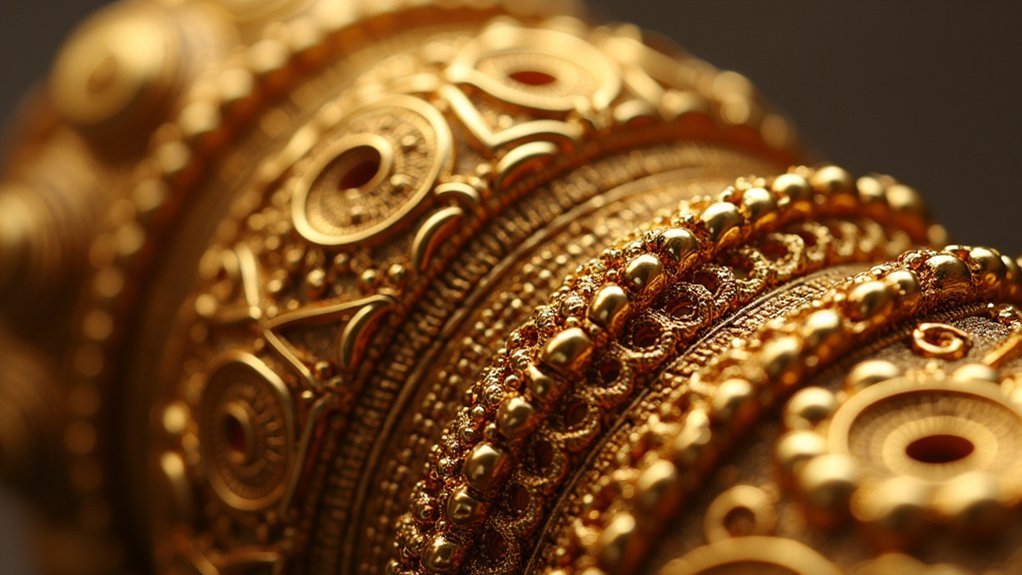
The Incas transformed raw gold into sophisticated alloys by masterfully blending it with copper and other metals, creating jewelry that wasn’t just beautiful but remarkably durable.
The Incas masterfully transformed raw gold into durable, sophisticated alloys by expertly blending it with copper and other precious metals.
You’ll find their gold alloy creation techniques produced stunning color variations while enhancing the metal’s strength. Their goldsmiths primarily worked with 18-karat gold containing approximately 78% pure gold, demonstrating their advanced understanding of metal composition’s impact on quality.
These precious metals weren’t chosen randomly. The Incas inherited knowledge from earlier cultures like the Mochica, who pioneered sophisticated gilding techniques.
When the Incas conquered the Chimu in 1470, they absorbed their metalworking expertise, elevating imperial jewelry production.
You’d discover that Inca goldsmiths were considered alchemists, revered for their specialized knowledge and elevated societal status through their mastery of metal transformation.
Advanced Gilding Techniques for Surface Enhancement
You’ll discover that Incan artisans perfected depletion gilding, a sophisticated method where they’d leach copper from gold-copper alloy surfaces to create a pure gold exterior layer.
This technique allowed them to transform the visual appearance of their jewelry while maintaining the structural benefits of the stronger copper-gold alloy beneath.
Their copper alloy innovations weren’t just about durability—they strategically manipulated metal compositions to achieve specific colors and surface qualities that enhanced the ceremonial significance of their pieces.
Depletion Gilding Methods
While many civilizations developed basic gilding techniques, Incan artisans perfected depletion gilding to achieve surfaces of extraordinary richness and purity. You’ll discover that this sophisticated method involves selectively removing copper from gold-copper alloys, creating a lustrous pure gold surface layer.
| Process Step | Method | Result |
|---|---|---|
| Alloy Preparation | Mix gold with copper | Workable base metal |
| Surface Treatment | Apply controlled acid or abrasion | Copper removal begins |
| Selective Leaching | Target copper molecules | Pure gold layer emerges |
| Design Application | Create intricate patterns | Enhanced visual appeal |
| Final Polish | Refine surface texture | Mirror-like finish |
In ancient Peru, this technique transformed ordinary gold alloys into sacred artifacts worthy of Inti, the sun god. You’re witnessing metallurgical mastery that required precise understanding of chemical reactions and surface enhancement methods.
Copper Alloy Innovations
Building upon depletion gilding mastery, Incan artisans revolutionized metalworking through sophisticated copper alloy innovations that expanded their creative possibilities beyond pure gold surfaces.
You’ll discover they blended gold with copper and other metals, creating 18-karat gold containing 78% gold content that enhanced durability while maintaining luxury appeal.
These copper alloys enabled you to achieve various gold hues, each carrying distinct divine associations within Incan culture.
The Mochica culture’s advanced gilding techniques allowed craftsmen to produce intricate designs that showcased wealth and status effectively.
You’d recognize these goldsmiths as true alchemists, manipulating metal properties to create symbolically important jewelry.
Their innovations elevated ceremonial significance, as rulers and elite members wore these divine-linked adornments during sacred rituals, connecting earthly power to spiritual authority.
Precision Bead-Making and Mosaic Construction Methods
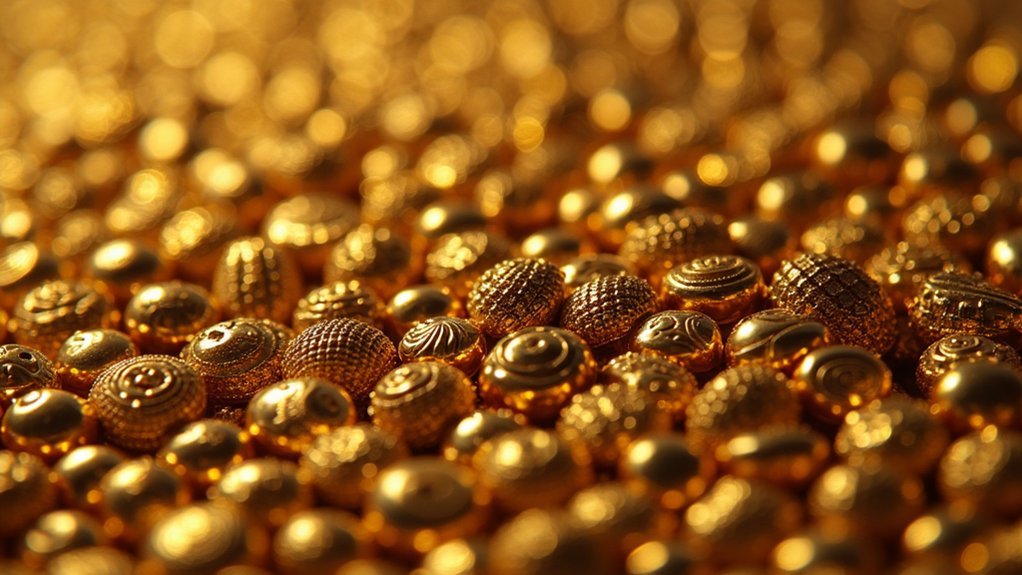
You’ll discover how Incan artisans achieved extraordinary precision using basic bone chisels and stone hammers to craft uniform beads with intricate designs.
Their mosaic assembly techniques required meticulous placement of colorful stones and materials to create detailed patterns that carried deep symbolic meaning.
These advanced methods demonstrate the remarkable skill level needed to produce jewelry that wasn’t just decorative but also conveyed social status and religious beliefs.
Ancient Tool Precision Methods
Three fundamental precision methods defined Incan jewelry craftsmanship: bead-making, mosaic construction, and surface finishing techniques that transformed simple tools into instruments of remarkable accuracy.
You’ll find that Incan artisans achieved extraordinary precision using bone chisels and stone hammers to craft uniform beads from gold and silver. They’d meticulously arrange tiny colored stone pieces into detailed mosaics, demonstrating remarkable consistency. Abrasive sand served as their polishing agent, creating smooth, lustrous surfaces.
| Tool Type | Material | Purpose | Technique | Result |
|---|---|---|---|---|
| Chisels | Bone | Cutting | Precise strikes | Uniform beads |
| Hammers | Stone | Shaping | Controlled force | Detailed forms |
| Sand | Natural abrasive | Polishing | Circular motions | Smooth finish |
| Templates | Stone/Wood | Measuring | Size consistency | Regular patterns |
| Burnishers | Smooth stone | Surface work | Pressure application | High luster |
These methods enabled granulation and lost-wax casting for complex ceremonial designs.
Mosaic Pattern Assembly Techniques
Incan artisans channeled their precision tool mastery into sophisticated mosaic assembly techniques that transformed individual beads into complex narrative artworks.
You’ll discover they carefully assembled uniformly shaped pieces using gold, silver, and semi-precious stones to create intricate geometric patterns. These mosaic pattern assembly techniques reflected cultural beliefs about duality and reciprocity, conveying deep symbolic meaning through visual complexity.
You’d be amazed by their meticulous craftsmanship—each bead was shaped and polished using simple chisels and stone hammers.
Advanced gilding techniques allowed artisans to combine different metal alloys, enhancing both durability and aesthetic appeal.
Archaeological discoveries like the Lord of Sipan’s tomb reveal these sophisticated methods created jewelry that signified elite status and divine connections, showcasing the Incans’ innovative ability to merge artistry with spiritual significance.
Bead Uniformity Creation Skills
Achieving perfect bead uniformity demanded extraordinary skill and patience from Incan artisans, who transformed raw materials into precisely sized components through methodical chiseling and shaping techniques.
You’d witness these craftsmen employing bone chisels and stone hammers to achieve consistent shapes, ensuring harmonious aesthetics throughout their jewelry designs. The artisan’s skill became evident through their meticulous use of abrasive materials like sand, which smoothed and polished each bead to create visually appealing, reflective finishes.
Essential Bead Uniformity Techniques:
- Precise chiseling methods for consistent size control
- Sand abrasive polishing for smooth, reflective surfaces
- Bone chisel and stone hammer tools for shape consistency
- Material combination techniques using gold and semi-precious stones
- Mosaic pattern arrangement creating elaborate, detailed designs
Sacred Symbol Integration in Ceremonial Pieces
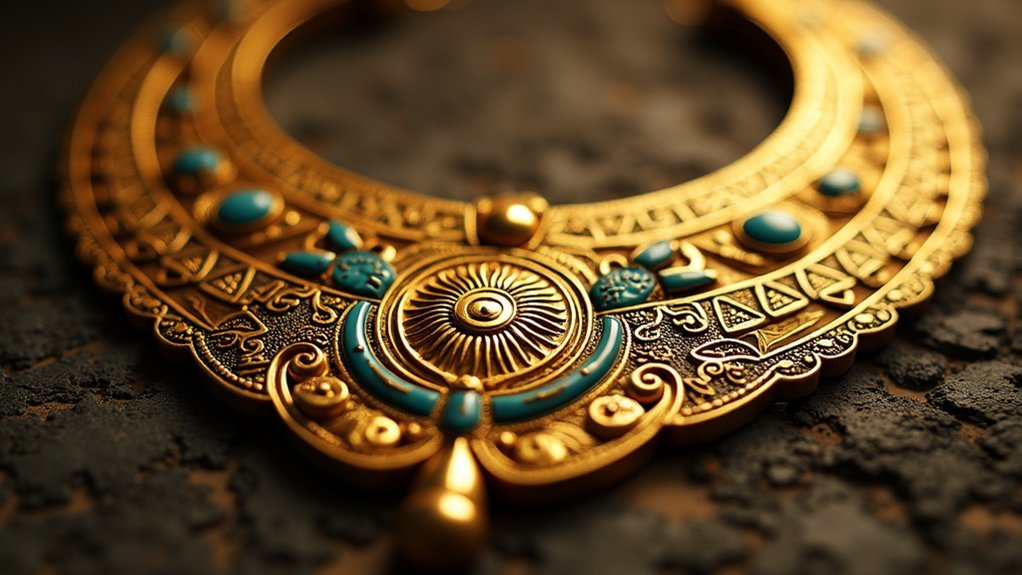
When you examine Incan ceremonial jewelry, you’ll discover that sacred symbols weren’t merely decorative elements—they served as spiritual conduits connecting the wearer to their complex tripartite cosmology.
You’ll find snakes, birds, and felines strategically incorporated into ceremonial pieces, each representing distinct domains: the upper world, present world, and world of the dead.
These sacred symbols carried profound political and religious significance, linking wearers to their ancestors and the afterlife.
You’ll notice that divine figures depicted in the iconography demonstrated the wearer’s spiritual status and authority.
Master artisans used advanced gilding and alloying techniques to create intricate designs that enhanced these symbols’ ceremonial impact.
The integration wasn’t random—each symbol’s placement and execution reinforced the wearer’s connection to Incan cosmological beliefs and divine power.
Lost-Wax Casting Adaptations for Complex Designs
To bring these sacred symbols to life with unparalleled precision, master artisans employed sophisticated lost-wax casting techniques that transformed their spiritual visions into tangible gold masterpieces.
You’ll discover that Incan craftsmen created intricate wax models of their desired pieces, then encased them in clay molds before pouring molten gold into the cavities left behind after melting the wax away.
This revolutionary process allowed them to achieve breathtaking detail in their gold jewelry, featuring complex representations of deities and culturally significant animals that defined their civilization.
- Precision modeling: Wax prototypes enabled intricate design development
- Complex shapes: Three-dimensional forms impossible with hammering techniques
- Fine detailing: Delicate features and symbolic elements preserved perfectly
- Cultural storytelling: Sacred narratives embedded within jewelry structures
- Status symbols: Elite connections demonstrated through sophisticated craftsmanship
Hammering and Shaping Techniques for Ornamental Forms
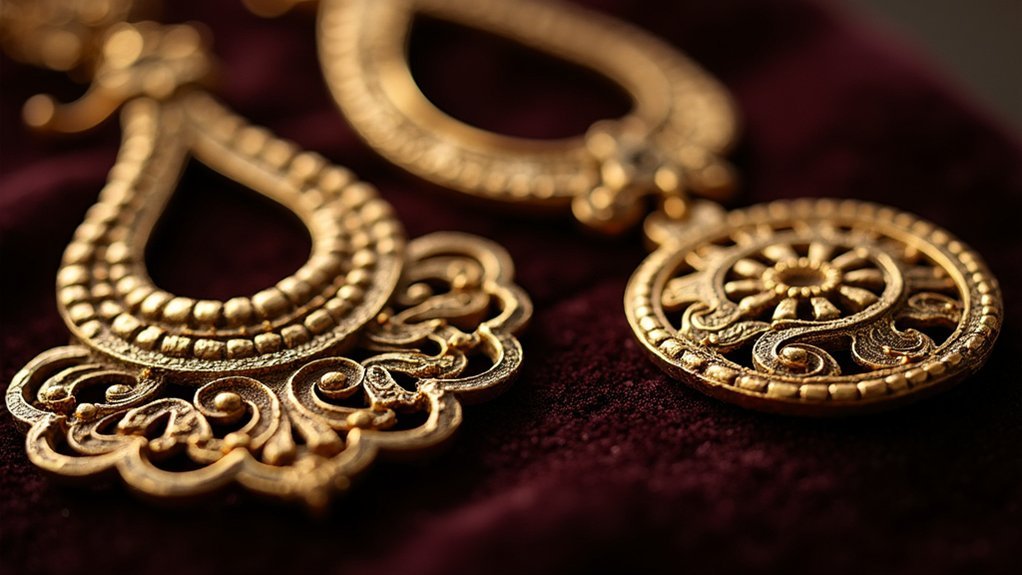
You’ll discover that Incan artisans relied on stone hammers and bone chisels to transform raw gold into stunning ornamental pieces through careful hammering techniques.
They’d repeatedly work the metal to achieve the perfect balance between durability and malleability, allowing them to shape intricate forms like delicate earrings and elaborate necklaces.
You can see how these craftsmen combined their hammering expertise with surface texturing methods to create complex patterns that conveyed both artistic beauty and cultural meaning.
Ancient Hammering Tools Used
Although modern jewelry makers rely on sophisticated machinery, ancient Incan artisans achieved remarkable precision using surprisingly simple hammering tools crafted from stone and wood.
You’ll discover that these artisans leveraged the natural weight and specific shapes of their tools to transform raw gold into delicate gold sheets and intricate ornamental forms. Their deep understanding of each tool’s properties enabled them to manipulate gold’s exceptional malleability without breaking the metal during the shaping process.
- Stone hammers – Heavy, durable tools for initial gold shaping and flattening
- Wooden mallets – Lighter implements for detailed work and finishing touches
- Weighted tools – Specifically designed shapes for creating consistent thickness
- Precision instruments – Smaller tools for intricate design work and fine details
- Specialized forms – Custom-shaped tools for specific ornamental patterns and motifs
Shaping Gold Into Forms
Three fundamental hammering techniques enabled Incan artisans to transform raw gold into sophisticated ornamental forms that captured both divine symbolism and artistic excellence.
You’ll discover that these master craftsmen employed strategic hammering methods using stone tools to create intricate textures and detailed patterns. When shaping gold, they’d carefully manipulate the metal’s malleability through controlled strikes, allowing them to form complex three-dimensional structures.
The chasing technique revolutionized their approach to ornamental forms by creating raised designs that brought jewelry to life.
You’d witness artisans hammering from the reverse side to push specific areas forward, forming symbolic representations of animals and divine figures. This meticulous process required extraordinary skill, as each strike had to be precisely calculated to achieve the desired depth and definition while maintaining the gold’s structural integrity throughout the transformation process.
Ornamental Pattern Creation Methods
Building upon these foundational shaping methods, Incan artisans developed sophisticated pattern creation techniques that transformed simple gold forms into masterworks of ornamental art.
You’ll discover that these skilled craftsmen mastered chasing and repoussé techniques, creating raised and engraved designs that brought texture and dimension to their jewelry.
They’d carefully strike patterns into metal surfaces using bone chisels and stone hammers, achieving remarkable precision in their ornamental patterns.
Key Pattern Creation Methods:
- Chasing technique – Engraving designs into gold surfaces from the front
- Repoussé method – Hammering patterns from behind to create raised reliefs
- Animal motif shaping – Crafting intricate wildlife representations
- Geometric pattern formation – Creating complex mathematical designs
- Textural enhancement – Adding dimensional depth through strategic hammering
Gold and Silver Duality Combination Methods
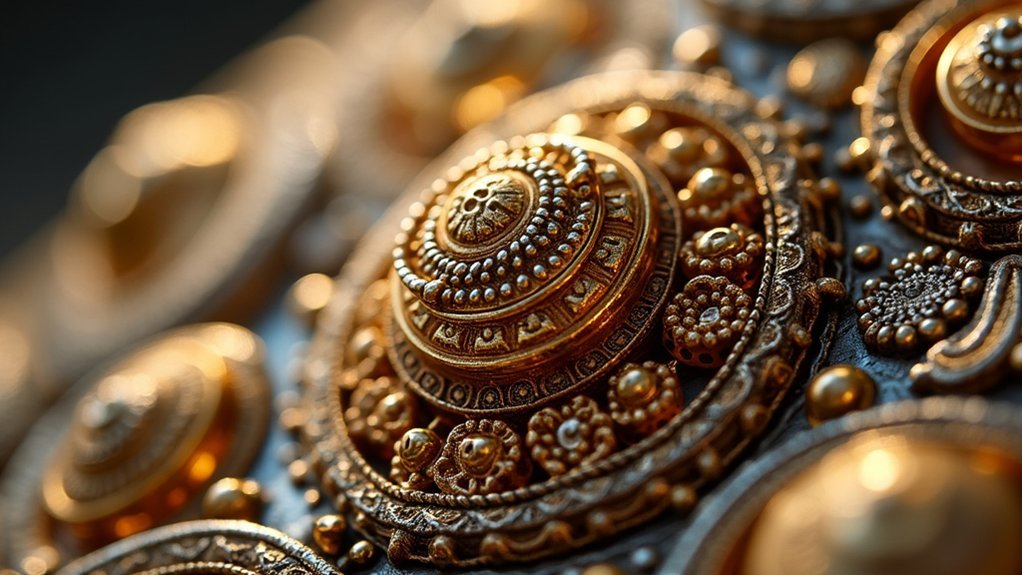
When Incan goldsmiths crafted jewelry, they deliberately combined gold and silver to create powerful symbolic statements about cosmic balance. You’ll find that this duality wasn’t merely decorative—it represented fundamental spiritual beliefs about masculine and feminine forces in nature.
| Material | Symbolism | Divine Connection |
|---|---|---|
| Gold | Sun/Masculine | Solar deities |
| Silver | Moon/Feminine | Lunar goddesses |
You’d see artisans employing depletion gilding techniques, creating pure gold surfaces over silver bases while maintaining the symbolic duality beneath. They’d enhance durability by adding copper, producing 18-karat pieces with 78% gold content. These gold and silver combinations weren’t random—they conveyed complex cultural narratives about reciprocity and balance, reinforcing your social status and divine connections during ceremonial contexts.
Intricate Filigree Work for Elite Accessories
Beyond their mastery of gold and silver combinations, Incan artisans elevated their craft through intricate filigree work that transformed noble accessories into breathtaking displays of technical virtuosity.
Incan filigree work exemplified extraordinary craftsmanship, weaving delicate gold threads into magnificent accessories that demonstrated both artistic mastery and cultural sophistication.
You’ll discover that these skilled craftsmen twisted fine gold threads into elaborate patterns, creating delicate designs that showcased exceptional artistry. This ancient technique allowed them to craft elite accessories that symbolized wealth and social status within their civilization.
- Divine motifs – Incorporated spiritual figures and natural elements reflecting cultural beliefs
- Status symbols – Elite accessories conveyed social hierarchy through artistic complexity
- Technical mastery – Fine gold threads twisted into intricate, delicate patterns
- Combined techniques – Filigree work enhanced with other goldsmithing methods
- Cultural significance – Designs represented spiritual connections and societal values
Stone and Shell Inlay Integration Processes
While filigree work demonstrated the Incans’ mastery of gold manipulation, their artisans achieved even greater visual impact by integrating precious stones and shells into their jewelry through sophisticated inlay processes.
You’ll find that these inlay techniques required meticulous precision as craftsmen cut turquoise, lapis lazuli, and mother of pearl to fit perfectly into gold and silver designs. The vibrant colors of gold combined with brilliant stones created intricate patterns that weren’t merely decorative—they carried spiritual significance.
This duality represented harmony between earthly and celestial domains. You can see this mastery in ceremonial headdresses and elite necklaces found in archaeological sites, where the sophisticated inlay work reveals exceptional artistry that symbolized divine connection and high social status.
Divine Connection Through Ritualistic Crafting Practices
As Incan artisans shaped each piece of gold jewelry, they weren’t simply creating decorative objects—they were forging sacred connections between the earthly and divine domains.
You’d witness these master craftsmen incorporating ritualistic practices into every step of their goldworking process, believing their spiritual devotion enhanced each piece’s divine power.
When you examine their techniques, you’ll discover how they channeled religious beliefs through advanced methods like alloying gold with silver to represent celestial dualities.
Their ritualistic approach transformed ordinary metals into sacred vessels connecting wearers to gods and afterlife.
- Divine symbolism integration – Snakes, birds, and felines representing tripartite world
- Ceremonial gold-silver combinations – Masculine sun and feminine moon energies
- Spiritual enhancement techniques – Sacred stone incorporation for divine connection
- Religious ceremony preparation – Jewelry crafted specifically for ritual adornment
- Advanced goldsmithing methods – Alloying and gilding for ceremonial purposes
Frequently Asked Questions
How Did the Incas Refine Gold?
You’d refine gold using lost-wax casting, creating wax models encased in clay for intricate designs. You’d blend gold with copper for durability and apply thin gilding layers over metals using sophisticated metallurgical techniques.
What Kind of Jewelry Did the Incas Wear?
You’d wear elaborate headpieces, earrings, nose ornaments, necklaces, and bracelets crafted from gold and silver. These pieces featured divine motifs like snakes, birds, and felines, symbolizing your elite status and spiritual connections.
What Are the Inca Golden Rules?
You’ll find the Inca golden rules weren’t literal gold guidelines but moral principles: reciprocity (ayni), collective work (minga), and balance with nature. They governed social behavior, not jewelry-making techniques or goldsmithing practices.
What Was More Valuable Than Gold to the Incas?
You’d find textiles were more valuable than gold to the Incas. They used intricately woven fabrics as currency, trade items, and status symbols, considering them precious because of the skilled craftsmanship required.
In Summary
You’ve discovered the sophisticated techniques that made Incan goldsmiths legendary artisans. These methods aren’t just ancient crafts—they’re blueprints for creating extraordinary jewelry that honors both tradition and innovation. You’ll find that mastering even one of these techniques can transform your metalworking abilities. Whether you’re drawn to lost-wax casting or intricate filigree work, you’re now equipped with knowledge that’s survived centuries and continues inspiring modern jewelers worldwide.



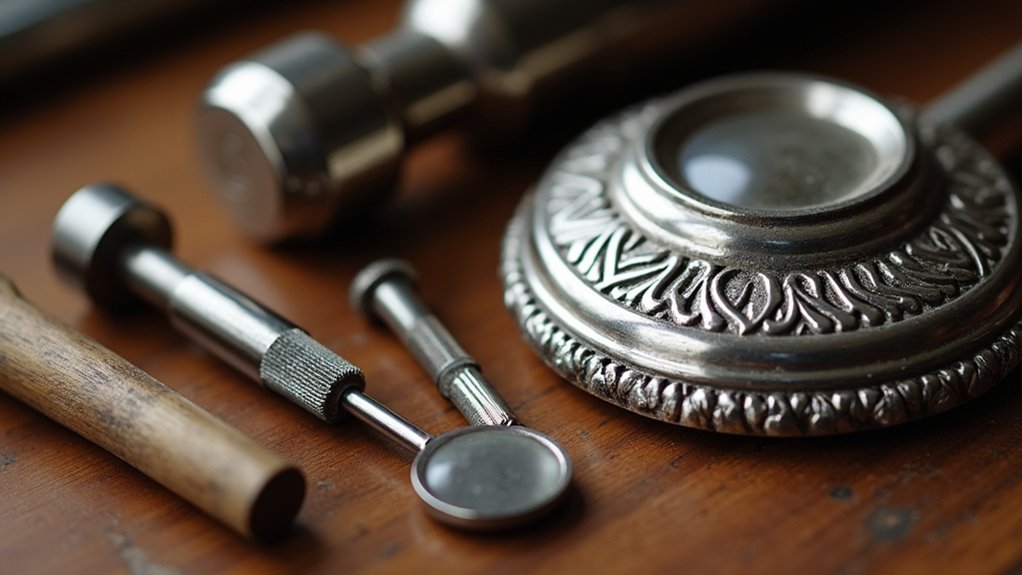
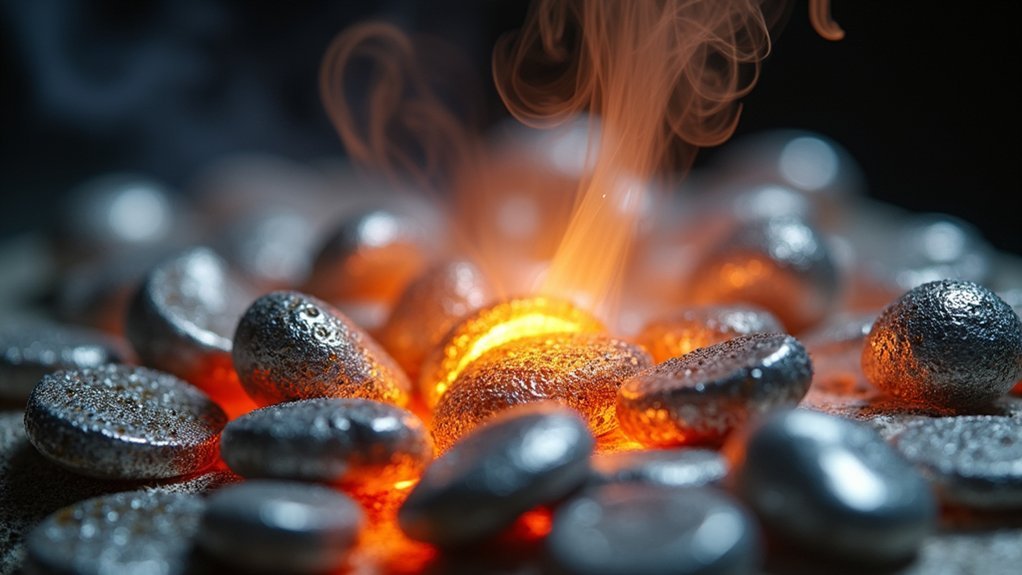
Leave a Reply